To Know a Mountain
The mountain is impossible to ignore. I see it from my window first thing in the morning and last thing before the light fades - nearly at midnight on a summer's night. I see it when I ride to and from town, and when I ride in loops around the countryside. No matter where I go and what I do, the mountain is always there, an enormous living, breathing thing, looming over the landscape.
At 1,263 feet, Binevenagh (pronounced "be-NEvna") is actually quite small. But it cuts a dashing figure on the Limavady landscape. It stands alone, outlined crisply against the ever-changing sky. Seen from the seashore, it resembles a crumpled old hat (or the snake that ate the elephant drawing from the Little Prince). From other vantage points, a jagged edge protrudes. Steep on all sides, it is topped with a large lumpy plateau, covered with forests and meadows.
Gazing at the mountain everywhere I went, all I could think of was climbing it. I hesitated at first. It felt so special I did not want to rush it. But finally one morning I woke up and knew it was time. The atmosphere was festive.
The road up Binevenagh starts directly from the house. But a friend suggested I take a detour - swinging around the coast, then turning onto another road to give myself a bit of a warmup before the climb. "Even with that frying pan of yours, you'll need it!" He was referring to the 11-36t cassette my bike was decorated with.
The ascent is relatively short and steep: 1,045 feet of climbing over 3.5miles. It is continuous climbing, much of it at a 10%+ grade, the road steepening, letting up, then steepening again. Right off the bat, the pitch was tough. I went at a good rhythm, but after a mile stopped to take a breather at a crossroads. Most of the mountain continued to tower ahead; I had hardly chipped away at it.
But when I turned around, the evidence of the mile I'd already done was in plain sight: A sharp dip, and the hills of Donegal spread out behind a shimmering sliver of water. Still narrow from this vantage point, the Lough Foyle is a saltwater inlet that separates the western part of Northern Ireland from the northwestern tip of the Republic. The border between the two nations is rather picturesque here. Climbing Binevenagh, the view becomes more breathtaking with each push of the pedals. And the sheep become more frequent.
How to describe this climb... The pitch was doable in my low gears. But the continuous steep grade made it tiring. I switched between my 3-4 lowest cogs and stood up occasionally (something I've finally learned to do), and tried not to get overwhelmed. I ignored my legs and focused on the scenery, aiming my eye at the top. As I kept going, the sheep were like loyal spectators. They looked at me with sympathy, understanding, encouragement. I was not miserable on the climb; it was a peaceful and oddly calming experience.
I watched him disappear down the other side of the mountain, as beautifully as he climbed. Later I learned he was a retired Irish pro-racer.
This descent was a heavily shaded one, winding its way through a forest.
After some S-bends, another sharp bend follows before a vertical drop onto the main road across from the water.
The spot is Downhill - defined by the magnificent view of the Mussenden Temple - a round structure at the edge of a cliff, which a nobleman had built for his niece... with whom he may or may not have had an affair with. The niece died before the temple was finished, infusing the story with an extra air of tragic poeticism.
At 1,263 feet, Binevenagh (pronounced "be-NEvna") is actually quite small. But it cuts a dashing figure on the Limavady landscape. It stands alone, outlined crisply against the ever-changing sky. Seen from the seashore, it resembles a crumpled old hat (or the snake that ate the elephant drawing from the Little Prince). From other vantage points, a jagged edge protrudes. Steep on all sides, it is topped with a large lumpy plateau, covered with forests and meadows.
Gazing at the mountain everywhere I went, all I could think of was climbing it. I hesitated at first. It felt so special I did not want to rush it. But finally one morning I woke up and knew it was time. The atmosphere was festive.
The road up Binevenagh starts directly from the house. But a friend suggested I take a detour - swinging around the coast, then turning onto another road to give myself a bit of a warmup before the climb. "Even with that frying pan of yours, you'll need it!" He was referring to the 11-36t cassette my bike was decorated with.
The ascent is relatively short and steep: 1,045 feet of climbing over 3.5miles. It is continuous climbing, much of it at a 10%+ grade, the road steepening, letting up, then steepening again. Right off the bat, the pitch was tough. I went at a good rhythm, but after a mile stopped to take a breather at a crossroads. Most of the mountain continued to tower ahead; I had hardly chipped away at it.
But when I turned around, the evidence of the mile I'd already done was in plain sight: A sharp dip, and the hills of Donegal spread out behind a shimmering sliver of water. Still narrow from this vantage point, the Lough Foyle is a saltwater inlet that separates the western part of Northern Ireland from the northwestern tip of the Republic. The border between the two nations is rather picturesque here. Climbing Binevenagh, the view becomes more breathtaking with each push of the pedals. And the sheep become more frequent.
How to describe this climb... The pitch was doable in my low gears. But the continuous steep grade made it tiring. I switched between my 3-4 lowest cogs and stood up occasionally (something I've finally learned to do), and tried not to get overwhelmed. I ignored my legs and focused on the scenery, aiming my eye at the top. As I kept going, the sheep were like loyal spectators. They looked at me with sympathy, understanding, encouragement. I was not miserable on the climb; it was a peaceful and oddly calming experience.
For some time, the sheep were my only company. Until, out of nowhere, a man in blue pulled up next to me. Even as I spotted him in my peripheral vision, I knew he was a Cyclist. Slender and agile, he moved so fluidly, it looked like liquid pouring uphill. Riding next to me, he matched my pace effortlessly as we talked. He lived nearby and loved to train on this mountain. He was an endurance cyclist, and rode in the Race Across America last year. Before we parted ways at the top, he introduced himself: Joe Barr.
I watched him disappear down the other side of the mountain, as beautifully as he climbed. Later I learned he was a retired Irish pro-racer.
The top of Binevenagh... The plateau covers a large area, and the highest point is somewhat uneventful. A painted bridge over a stream, a scraggly meadow with Queen Anne's Lace and buttercups, a forest in the background, and lots of sky with very distant views of water. From here on, there are several options for descending. One starts right away and is fairly steep and twisty, consistently throughout. Another is further down the plateau. It is longer and gentler most of the way, until it ends in a sudden, sharply winding vertical drop to the sea at the very end.
To start with I chose the first descent. The steep, narrow, winding road pushed my comfort zone. I was in control around the bends, but had to work on myself to keep calm. I did breathing exercises to keep from shaking and destabilising the bike. Descending on the left side of the road felt intuitive; my brain had already switched over.
But after every bend, a view opened up, each more beautiful than the next. If it is possible to feel both cautious and relaxed at the same time, that is how descending this road felt.
Cars passed me up the road occasionally, the drivers waving, friendly - something I am still getting used to here. Toward the bottom, one driver was trying to communicate something urgently, which I did not understand - until I saw a row of pointy brown ears up ahead. Quickly I stopped, dismounted and clambered up the side of the road to let the herd of cows pass.
The final winding stretch dumped me onto the coastal road unceremoniously. Feeling sad it was over, I repeated the loop, then crawled home, spent and drunk on mountain air.
Several days later, I climbed Binevenagh again to try one of the other descents. The road along the plateau offered wide open views of both the Lough Foyle and the North Atlantic.
I rode through a dreamscape of hot-pink sheep grazing upon neon green grass, as the sun came out over the hills of Donegal.
At the far end of the plateau stood "the boat man," as the locals refer to him. He is Manannán mac Lir, a god of the sea - a new statue the local council has erected just in the past week. Facing Magilligan Point (entrance to the Lough Foyle on the Northern Ireland side) - the mythical wood-carved figure spreads his arms over land and water of the bordering nations.
Standing there, I remembered being at Magilligan Point, at the ground level, and looking up at the mountain from there. Some form of symmetry had been achieved.
The descent was long, tame and idyllic, rolling through farmlands. But at the end came the stretch I had been warned about: This section winds tightly, down a steep grade. I was advised to either walk or ride the brakes once I saw the crumbling rocks sign. Over the course of two loops, I tried both methods. Riding slowly with good brakes is actually a bit easier than walking the bike.
The spot is Downhill - defined by the magnificent view of the Mussenden Temple - a round structure at the edge of a cliff, which a nobleman had built for his niece... with whom he may or may not have had an affair with. The niece died before the temple was finished, infusing the story with an extra air of tragic poeticism.
I looked back at the road I had come down. I was not as shaken as I thought I'd be by the descent. But with the rush and the beauty of it over, I felt lost - so much emotion can build up along these stretches, and it has nowhere to go. Maybe that is why the cliffs looked especially beautiful in the evening light. And maybe that is why I put all my remaining energy into the 10 miles home along the flat coastal road. Big ring, small cog, setting sun, burning legs, cold air, sprays of water, and Binevenagh towering over it all. Turning the pedals madly as I raced home, I already longed to be up there again.

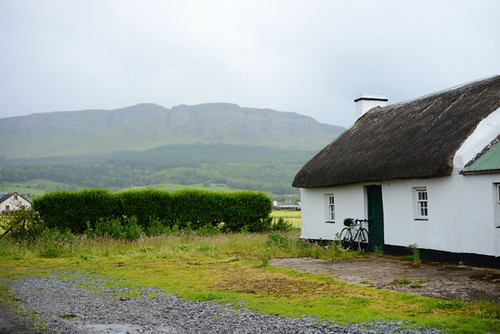
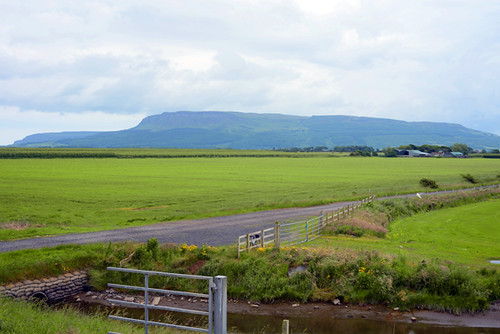
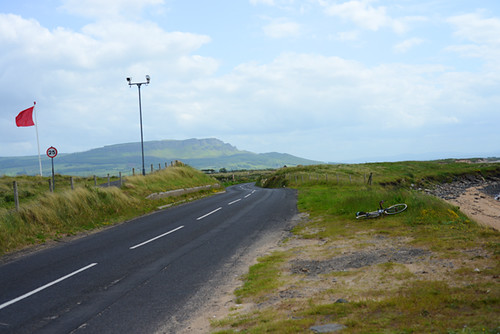
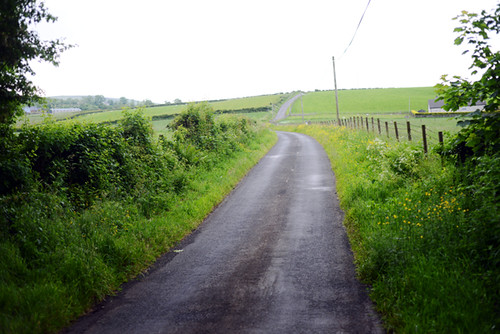
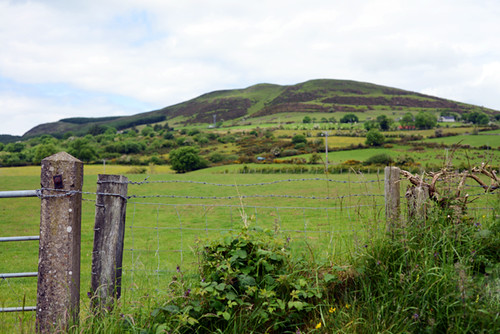
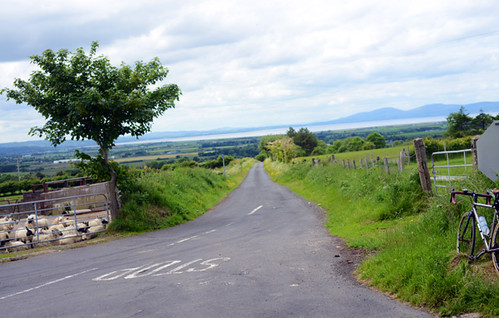
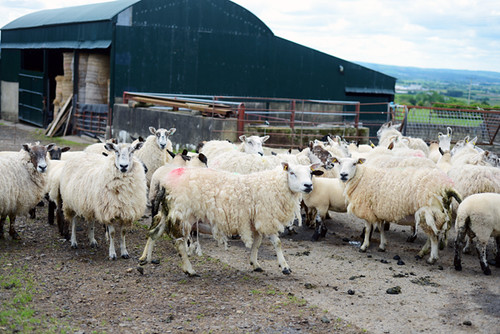
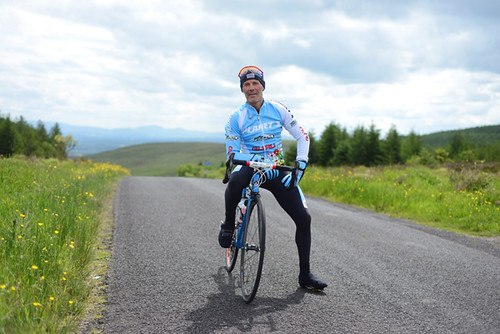
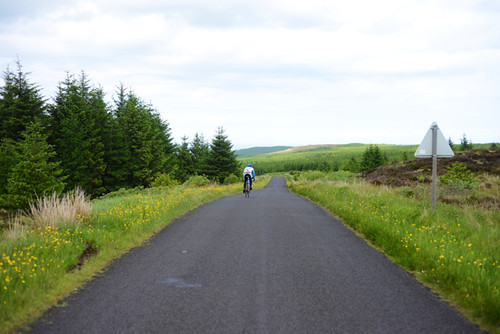
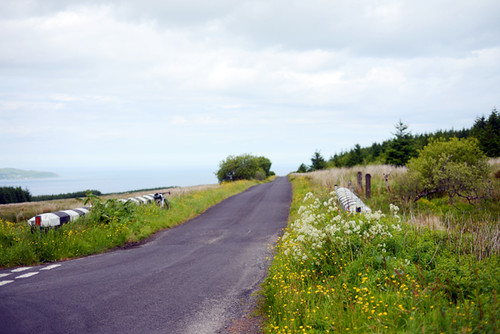
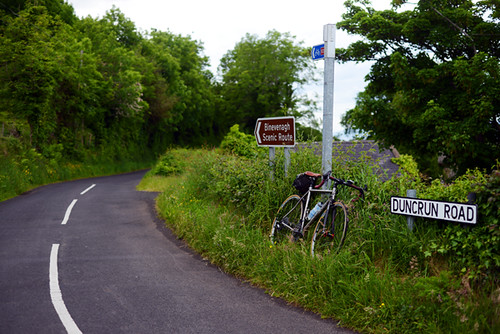
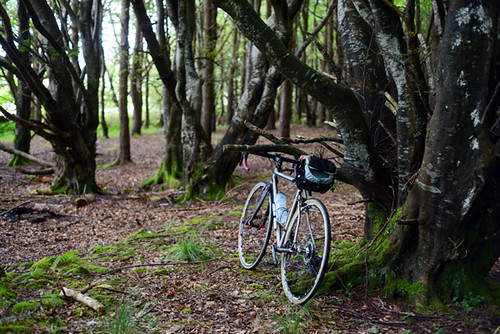
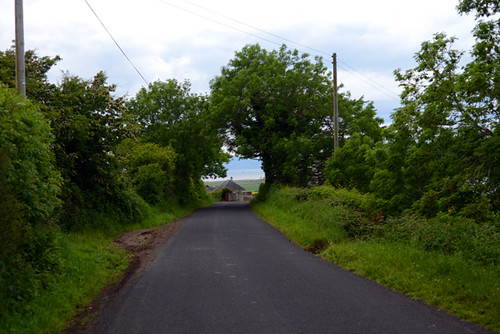
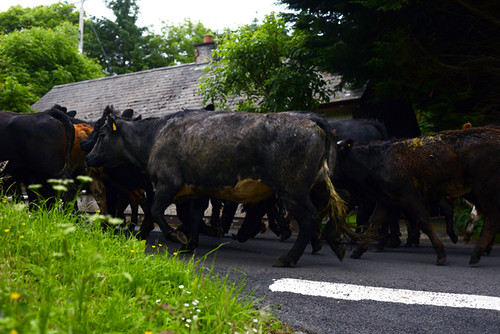
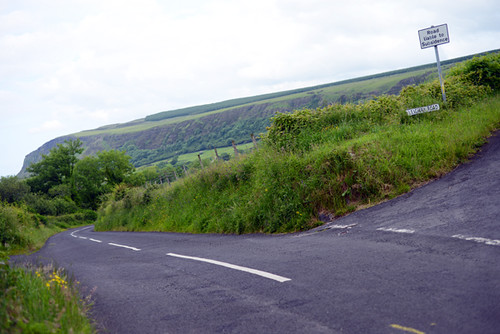
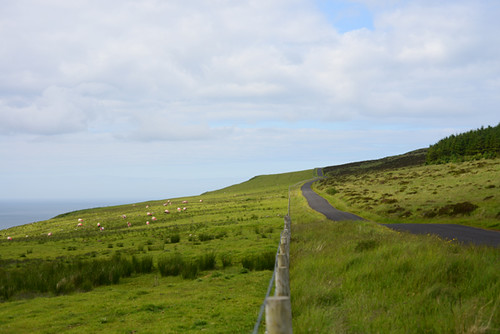
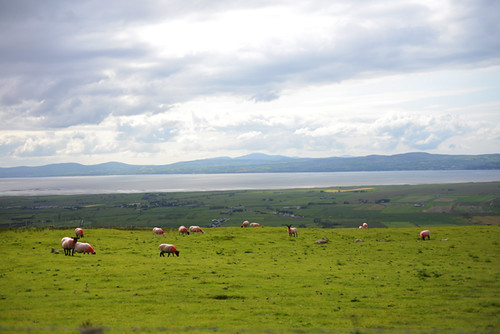
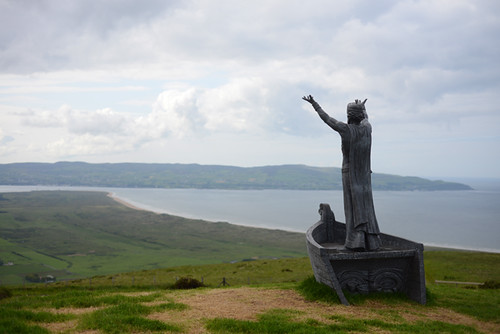
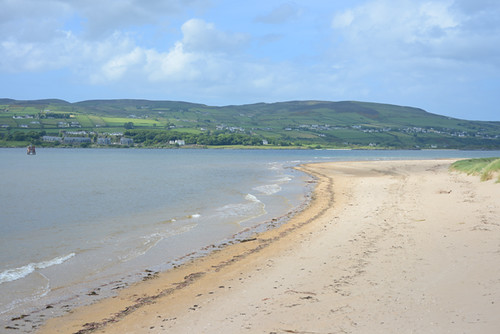
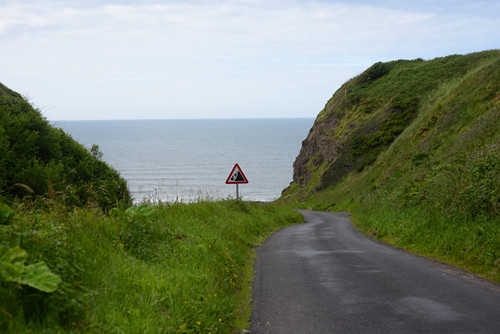


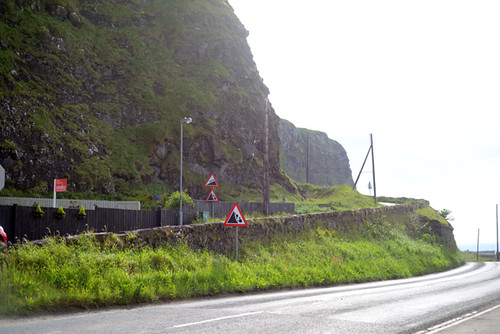
Beautiful!
ReplyDeleteCool. How many times have you climbed this thing now?
ReplyDelete4
DeleteLooks like an ideal piece of land to cycle around! Really though, these experiences/places are available everywhere and it's all part of biking. Whether one is an athlete or a poet the connection is what it's all about.
ReplyDeleteThis one is good, proof getting away improves the quality of experiences/writing.
ReplyDelete11x36 - ok glad you followed my ad...er went this direction. Of course staying with your Riv gearing would have been...foretelling.
I think your pizza pan really means you need to stand more and more to develop strength and variance, less you become an indoor spinning machine, which I'm sure has lead to past hyperventilating and needs for mid-climb stops. As long as your knees don't hurt you'll only get stronger...
Like with the descending.
Joe Barr, joe barr...his name rang a bell. Was following raam a bit but his name seemed to predate that. Looking him up now he contracted HAPE on it, not far off from death. A few others have done so in the past due to the Rockies. They aren't like normal mountains.
Speaking of which once you ride a real mtb on real mtn terrain a bit all this roadie bike handling stuff will seem quaint.
Descents are no harder on the 7. Center that Gravity, hit those brakes.
To get purely technical about it seated climbing is much more efficient than climbing while standing. Standing up the climbs leads quickly to hypertrophied muscles that most cyclists and all climbers are better off without. If you start off short of muscle and you do want a few then standing up the climbs is a great way to do it.
DeleteIt passes my understanding how it's possible to climb without standing at all. And it passes my understanding how V has come this far w/o what I think of as basic abilities. Good to see the pieces finally coming into place.
My sense is that, at least in part, which method is more efficient depends on individual physiology. I know riders with decades of experience who certainly can climb out of the saddle in a big gear, but usually don't - sitting and spinning works better for them.
DeleteMe, I am still learning what works for me. Not being physically able to stand is different from preferring not to stand. So I want to get to the stage where the skill or balance or whatever to do both is not an issue, and then see which I actually prefer. At the moment, the variance itself really is nice. Plus I am still on a "look, I can stand!" high, though I am not great at it yet.
Oddly, I almost never get out of breath from spinning. It is usually either pain in the legs or that horrible "blood to my head" feeling that gets me, both of which happen when pushing too big a gear. If I can spin a gear then I'm fine - albeit slow.
Pain in your legs - how inconvenient.
DeleteMeans you haven't been using those muscles to their full ability.
Blood in head is a different matter.
Of course there are riders who climb effectively out of the saddle. There will never be a shortage of that sort of example. Doesn't change the basic mechanics. It takes muscle and effort to stand and remain standing. It takes muscle and effort to brace the hips while standing so that the pedal stroke does anything. The saddle will perform the same service at no cost.
DeleteIf you look at anyone climbing standing you'll see a lot of extraneous motion that contributes nothing to getting the bike up the hill. The stillness you observed at the TT is always the better way to go. It takes a lot of class to simply get centred and exert hill-climbing power and be still and calm. On anything you could call a climb I've never completely succeeded.
Yes, the variance is really nice. I would've said necessary. And you have proved me wrong. But please continue to enjoy the variance. Seated climbing is more efficient but there is no rule at all for when you should sit and when you should stand. When it feels good.
Ah, fuck man! Sweating away in the heat of the midwest and reading about you spending time riding and writing in Ireland for the summer makes me wonder what I did wrong! Yup, climbing is fun, fun, fun and it looks like you've found a friendly place to do it. Kudos!
ReplyDeleteIf you like cold and rain, it really is wonderful. Just beware, it has not gone above 65F here so far (and more typically has been in the low 50s), and it rains at least a little every day. I thrive in this kind of whether, but others might be miserable.
DeleteI googled Joe Barr. What I found was that he DNF'd the 2012 RAAM after 1,000 miles. Not that he finished it.
ReplyDeleteYour pictures of that area of Ireland are stunning. What a magical place.
You clearly are smitten with mountain fever; your sweet absorption is contagious. Very prettily drawn. Jim Duncan
ReplyDeleteA retired racer (and intense one at that) stops in the middle of a ride to have several photos taken? How odd.
ReplyDeleteOr to ride slowly and talk to me, for that matter. But this was probably his Nth time up that mountain that day. And people are friendly here. They see someone new and want to know who you are, especially in an isolated place like that.
DeleteThat behavior was once and not so long ago universal on this side of the pond. When there are not so many riders around each one is cherished. Greg Lemond has turned around for me and I'm sure he still would if you crossed his path outside a metro area.
DeleteSo a painted bridge over a stream marks the top of the mountain--meaning water flows uphill. Ireland truly is a magical place!
ReplyDeleteThere is also a lake hidden in the woods at the peak, up a steep gravel road. Need to visit that next.
Deletebeautiful!
ReplyDeleteBeautiful pictures and lovely descriptive writing but I will just make a little correction. Mussenden temple is at Downhill - Castlerock is a little further around the coast.
ReplyDeleteThat's right, thanks - redacted.
DeleteDo the beating sheep make you laugh? The sight of those comical black and white faces, bleating madly, right beside the road, used to send me into fits of laughter, especially if I was concentrating on ascending steep hill. It seemed to diffuse the intensity of the climbs.
ReplyDeleteThere are so many different kinds! For the first few days here I couldn't get anything done, because I kept stopping to look at them. They are very curious too, will come right up to the fence and stare inquisitively. Only thing is, you have to watch out for them jumping across the road.
DeleteGetting to know hills is a fun task, if you can call it that. Getting to know any area well is worth it. Immersing yourself in an area seems like a great vacation or whatever you call this excursion.
ReplyDeleteAnd you aren't missing the best weather in Boston although great cycling is possible in the current conditions.
11/36 with a compact cranks is quite low gearing. My road bike now has 13/30 with a compact crank (and Jeff says it works). That's comparable to what I did the D2R2 with so it ought to get me up steep hills easily but maybe not the 1000+ feet over 3.5 mile hill you are experiencing.
It just really depends on your strength and style of riding.
DeleteThere is a NI hill climb time trial that does the exact climb I described here. Some riders choose racing gears, others choose similar gears to what I have - it's all over the place.
What a beautiful climb! Love to climb myself.
ReplyDeleteThat 11-36 "frying pan" in the back (for some reason I love that term) must give you 1-to-1 gearing at the low end. One could easily make quick work out of a mountain with that setup.
ReplyDeleteWhen you're done traveling, I hope you share how you packed and shipped your bike. On the plane, or perhaps shipped via FedEx or UPS?
Sub 1:1 even; I have a 50/34t in front.
DeleteI will definitely write about transporting my bike; I want to wait till I get back to the US to make sure it goes as smoothly on the return trip as it did on the way here. But the summary is that I used a Pika bike case and had no issues.
I'm particularly enjoying these articles: Northern Ireland sounds and looks very much like Aberdeenshire, which is where I'm doing my riding at the moment.
ReplyDeleteRe Queen Anne's Lace: is that the white-flowered, straight-growing, about waist-high plant in the picture? I ask because I noticed loads of that by the side of the road on a ride Yesterday, and wondered what it was called.
Descending: When I moved to South-West France near the Pyrenees those descents used to scare the proverbial out of me. My technique was to scream at the top of my lungs all the way through the braking zone before turning in to the hairpins. In retrospect, some nice breathing exercises would probably have been better.
I would think a retired racer would be most likely to stop and talk. They have nothing to prove.
ReplyDeleteVelouria, thanks so much for these lovely travelogues. They're beautiful and fascinating and I learn so much.
ReplyDeleteLove the gearing you're running. This will be like my setup when I conquer the Backroads Century in Va./W. Va. this year.